|

|

|
|
ポピュラス
©1989,1990 Bullfrog Productions
©1989,1990 Electronic Arts
Hudson Soft / Vol.37
Release : 1991-04-05(¥6900)
HuCard (4 Mbits) HC91041
Simulation game
|
Populous is a strategy game published by Hudson Soft and
conversion of Bull Frog's immensely popular title originally
released in 1989.
Not many games give the player the opportunity to incarnate an almighty
god and Populous grants such powers and gives the player
world domination on a plate. The game features several scenarios
where two civilizations (the blues and the reds) and their all
powerful gods fight for land, domination and try to conquer each others.
The game is displayed using a fairly clever 3D isometric view and a
cursor is used to interact with the terrain and any wandering villager.
The more followers the player has, the more Mana energy he receives which
can be used to shape the terrain, build armies, trigger devastative earthquakes,
change the weather or call for the powerful and final blow, the almighty Armageddon!
And the stronger are his people, the more the player
benefits. They also slowly evolve as they gain more land and transition
from weak prehistoric cavemen to strong medieval knights.
The ultimate goal of Populous is simple - the player must grow his
civilization, expand their towns and gain enough powers to defeat his
opponent.
|
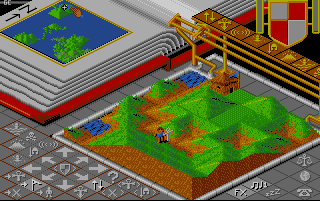 Populous was originally created by Bullfrog (led by Peter Molyneux)
and released in 1989 for the Amiga (picture on the right), Atari ST and PC Computers. The game was a worldwide
success and was ported for countless systems at the time, such as the NEC PC98 (1990),
Sharp X68000 (1990), Sega Megadrive (1990), NEC PC Engine (Hucard & Super CDRom², 1991),
Sega Master System (1991), Nintendo Super Famicom (1991),
Game Boy (1993, known as 'Populous Gaiden'), Acorn Achimedes and
Fujisu FM-Towns. As a side note, the Hucard version of the game (tested here) is a
straight conversion of the original game, and only the Super CDRom² version, called
Populous The Promised Lands features new and exclusive stages.
Although Bullfrog released all kind of expansion packs for Populous (mainly with new
landscape packs),
Populous was originally created by Bullfrog (led by Peter Molyneux)
and released in 1989 for the Amiga (picture on the right), Atari ST and PC Computers. The game was a worldwide
success and was ported for countless systems at the time, such as the NEC PC98 (1990),
Sharp X68000 (1990), Sega Megadrive (1990), NEC PC Engine (Hucard & Super CDRom², 1991),
Sega Master System (1991), Nintendo Super Famicom (1991),
Game Boy (1993, known as 'Populous Gaiden'), Acorn Achimedes and
Fujisu FM-Towns. As a side note, the Hucard version of the game (tested here) is a
straight conversion of the original game, and only the Super CDRom² version, called
Populous The Promised Lands features new and exclusive stages.
Although Bullfrog released all kind of expansion packs for Populous (mainly with new
landscape packs),
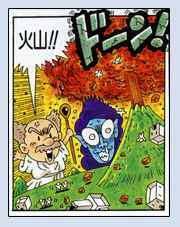 the first real sequel actually followed in 1991 and was called Populous II: Trials of the Olympian Gods.
The game was released for the Amiga (1991),
Atari ST (1992), Sharp X68000 (1992), PC/DOS (1993),
Megadrive (1992, surprisingly renamed 'Two Tribes: Populous II' and only released in
Europe), FM Towns (1993), NEC PC98 (1993)
and Super Famicom (1993).
As a side note, Powermonger was
released in 1990 and shared a lot in common with the original Populous. But it is
not considered a sequel and more of a 'derived' real-time war strategy game based on
Bullfrog's classic Populous.
Powermonger uses a really effective combination of real-time 3D polygons graphics and
isometric sprites.
Populous The Beginning was then released in 1998 for PC Computers and used
fairly good 3D polygonal graphics for the time. As a side note, Populous DS was released
for the Nintendo DS in 2008 and followed the formula laid down by the original game (although
I personally think it doesn't look as good).
the first real sequel actually followed in 1991 and was called Populous II: Trials of the Olympian Gods.
The game was released for the Amiga (1991),
Atari ST (1992), Sharp X68000 (1992), PC/DOS (1993),
Megadrive (1992, surprisingly renamed 'Two Tribes: Populous II' and only released in
Europe), FM Towns (1993), NEC PC98 (1993)
and Super Famicom (1993).
As a side note, Powermonger was
released in 1990 and shared a lot in common with the original Populous. But it is
not considered a sequel and more of a 'derived' real-time war strategy game based on
Bullfrog's classic Populous.
Powermonger uses a really effective combination of real-time 3D polygons graphics and
isometric sprites.
Populous The Beginning was then released in 1998 for PC Computers and used
fairly good 3D polygonal graphics for the time. As a side note, Populous DS was released
for the Nintendo DS in 2008 and followed the formula laid down by the original game (although
I personally think it doesn't look as good).
|
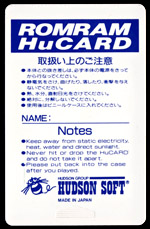 As you've probably noticed, Populous was released as an unusual and thick HuCard. Unlike
Street Fighter II', which was also
released on a similar HuCard, Populous doesn't apparently use this extra space for
additional memory. This extra thickness is in reality supposed to hide a
mini backup unit (and maybe a battery) where players could save they game's progress.
This feature was apparently called
a Rom Ram Hucard (picture on the right).
Interestingly, I did open the thick plastic part of a Street Fighter II'
HuCard once and well, it was just empty... maybe this was just done for looks and all the electronics is still located under the black part of the HuCard...
Additionally, it seems that Hudson Soft
eventually dropped the Rom Ram feature in Populous and the game wasn't
released with on-board Back-up support after all, although the game can apparently
use the saving feature from the Ten no Koe Bank (or any other official back up devices).
All of this is just speculations, really, maybe a first edition of Populous
did support such feature and was later removed to save on production costs...
Populous also comes in a thick double-CD box and, like Street Fighter II',
also includes a spine card.
As you've probably noticed, Populous was released as an unusual and thick HuCard. Unlike
Street Fighter II', which was also
released on a similar HuCard, Populous doesn't apparently use this extra space for
additional memory. This extra thickness is in reality supposed to hide a
mini backup unit (and maybe a battery) where players could save they game's progress.
This feature was apparently called
a Rom Ram Hucard (picture on the right).
Interestingly, I did open the thick plastic part of a Street Fighter II'
HuCard once and well, it was just empty... maybe this was just done for looks and all the electronics is still located under the black part of the HuCard...
Additionally, it seems that Hudson Soft
eventually dropped the Rom Ram feature in Populous and the game wasn't
released with on-board Back-up support after all, although the game can apparently
use the saving feature from the Ten no Koe Bank (or any other official back up devices).
All of this is just speculations, really, maybe a first edition of Populous
did support such feature and was later removed to save on production costs...
Populous also comes in a thick double-CD box and, like Street Fighter II',
also includes a spine card.
|
Game Staff (Copied from the introduction sequence) :
|
Populous
(c)1989,1990
Bullfrog Productions
Published by Electronic Arts
Programming and Design by
Glenn Corpes
and
Peter Molyneux
Technical Help from
Kevin Donkin
Graphics by
Glenn Corpes
Dan Wheeler
Sean Cooper
Andy Jones
& Peter Molyneux
|
|
Game Sound & Music by
Dave Hanlon
Music Idea by
Les Edgar
Title Music by
Rob Hubbard
Special Thanks yo
Hisoft for Devpac 2
Adrian Moore
Everyone at Ultima
Except Rob
|
|
PC Engine Version
Presented by Hudson Soft
Alpha System
Programming by
T. Tsuura
Also Programming by
Higepin
Music, SE & Voice by
M. Teramoto
Scored and Tone Analized by
M.Asai
Test Play by
M. Yamamoto
|
|
O
M
A
K
E
|
|
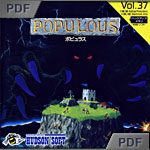
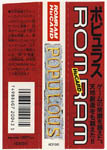
|
|
|
Click on picture to enlarge |
S
E
C
R
E
T
S
|
|
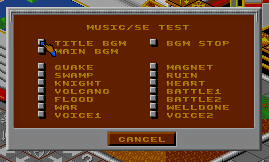 Sound/Music Test Screen:
Sound/Music Test Screen:
Start a game and press Run to activate
the option screen (the hand should now move over the icons on the right side of the screen).
Select the lowest icon on the right (it looks likes a Screen) and
hold Down, Right and press II. This
should activate the Music/SE Test Screen (picture on the right).
Press Run to play any sound effect or music from the game.
|
|
|
|
LK

|
|
Add your Pov here !
|
P
O
V
s
|
|
Populous was possibly the very first "God game" and Bullfrog's timeless
classic was a huge hit back in the days (and rightfully so). Even though it was ported to countless consoles (it was originally
released for the Amiga and home computers), I don't personally think it ever matched the intensity
produced by its original formula... and this is sadly often the case with games
designed to work with a mouse. This PC Engine conversion is well
executed and it is really faithful and incredibly true to its roots (Hudson Soft
even managed to fit the whole game
on a tiny HuCard!). But, again, the whole interface was designed to be used
with a mouse and using a D-Pad controller ends up being cumbersome and greatly
slows down your action.
Additionally, this HuCard port only includes the original game and four different world variations,
unlike Populous Promised Lands, the Super CDRom² version, which offers more worlds (and
even one exclusive to the PC Engine system!).
It is nevertheless a remarkable and fun port, but I would recommend fans of Bullfrog's masterpiece
to hunt down the Super CDRom² version instead.
|
|
|
|